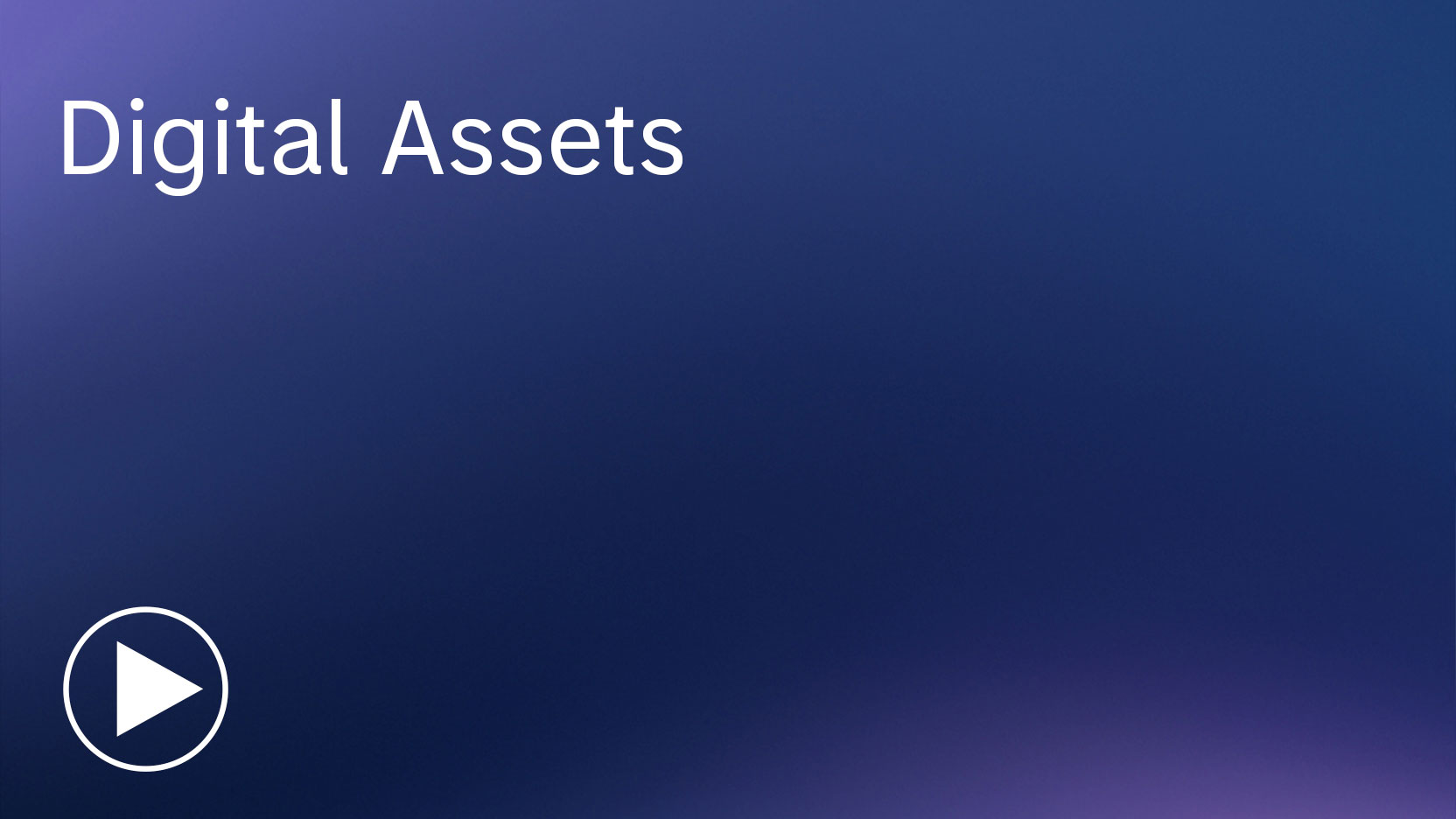
Transcript
Digital assets and cryptocurrencies have been one of the hottest investments of the last five years and have offered a very liquid way for investors to allocate to alternative investments designed to enhance portfolio returns. But what exactly are digital assets and cryptocurrencies?
Let’s start with the idea of distributed ledgers. Distributed ledger technology and blockchains are the backbone of the cryptocurrency and the digital asset industry. Investors who have assets in a bank or a brokerage firm have risk to the failure of that centralized counterparty. When you have a bank account or a brokerage account, your assets are held on a ledger that’s private to that bank or that brokerage firm. By moving into a distributed ledger, we’re dispersing the record-keeping across thousands of computers in dozens of countries around the world, reducing the risk of the failure of a single counterparty. When you’re holding your assets with a single bank or a single brokerage firm, you are within the currency and the regulatory regime of a single country.
You have to agree to hold your assets in dollars and be subject to the Federal Reserve or the SEC as your regulator. But when investors move into this world of distributed ledgers, now their assets can be tracked on a blockchain that is maintained on a worldwide basis and not necessarily subject to the rules of a specific country.
Digital assets are tracked on distributed ledgers secured by blockchain technology. Rather than having our assets in the ledger tracked by a single bank or a single brokerage firm, our assets are tracked on a ledger distributed across computers around the world.
Blockchain technology uses cryptography to track the provenance and ensure the security of the assets. The blockchain is the distributed ledger secured by cryptography. Any type of asset or data can be secured and tracked on a distributed ledger on a blockchain. For example, the title to all of the cars in California are now tracked on a blockchain.
Educational records for students in Africa are held on a blockchain. You could potentially own the title of your house on a blockchain, which can strengthen property rights in many countries. We’re blessed in the US to have the ability to own our house and our car with a secure title, but that’s not necessarily the case in other countries.
The promise of blockchains and distributed ledgers might be in real-world assets or tokenization, which could be the most important application of distributed ledger technology. Currently, the most valuable assets held on blockchains are cryptocurrencies, with the most dominant being Bitcoin and Ethereum.
Even though there are over 15,000 different cryptocurrencies in the world, between 60% and 70% of that value has historically been held in just two cryptocurrencies called Bitcoin and Ethereum. Bitcoin is the first successful, globally decentralized cryptocurrency that’s deemed to be a store of value, and can be compared to gold. Bitcoin can be spent or it can be saved. with a 2008 white paper by an anonymous creator, or creators named Satoshi Nakamoto. The paper explains the proof of work protocol. There are thousands of Bitcoin miners around the world who are competing to secure the Bitcoin network and to write these transactions to the Bitcoin blockchain.
Ethereum is a different proof of stake protocol. The miners don’t compete, but they actually cooperate on writing the transactions to the Ethereum blockchain. Now, Bitcoin has been called digital gold, which competes as a store of value while Ethereum has been called digital oil, which facilitates commerce because Ethereum operates the Ethereum virtual machine that runs smart contracts.
Smart contracts can build all types of different functionality with the result of those computer programs being written to the Ethereum blockchain. Ethereum is very different than Bitcoin. Ethereum started in 2014, so the known creators of the Ethereum blockchain benefited from the Bitcoin experience and they were able to improve on the functionality or add to the functionality of the Bitcoin blockchain.
It might surprise people to know that there’s more money flowing through the Stablecoin network than is flowing through the Visa and MasterCard networks. There’s a tremendous volume of high-dollar transactions moving through the world on the Stablecoin network, but Visa and MasterCard still process a much larger number of smaller transactions.
Bitcoin and Ethereum prices are highly volatile, with over 70% annualized volatility, four times the volatility of the NASDAQ stock market. But stablecoins are designed to be stable, pegged to the value of $1, pegged to the value of one euro, or pegged to the value of one ounce of gold.
A dollar-based stablecoin is designed to be always priced at a dollar. Stablecoins allow global investors to hold Euros or US dollars, even if their home currency’s banking system doesn’t allow that. It allows people to move money out of Venezuelan Bolivars and out of Zimbabwe dollars that are subject to high degrees of inflation. It allows consumers to move their money out of fragile banking system, such as Ukraine, and allows them to hold dollars or euros or gold on a blockchain, external to their home country banking system.
Stablecoins allow investors to protect against the inflationary environments in Venezuela and Zimbabwe and protect against weak banking systems that’s prone to physical failures, in a country such as Ukraine.
The smart contracts that run on the Ethereum virtual machine allow for the creation of distributed applications or DApps, which could recreate business models to run on blockchains and distributed ledgers.
This global distributed computing environment could be used to run new businesses, like Defi, decentralized Finance, which seeks to recreate banks or brokerage firms on a global basis. The banking system can be recreated with borrowing and lending markets across borders in a single fiat currency, like dollars and euros, or in the value of cryptocurrency. We’re also seeking to recreate the brokerage system. Around the 2024 election, there was a lot of news about crypto-based prediction markets where forecasters can profit from their views based on the outcome of an election, the outcome of a market, or a sporting event. The combined predictions of these thousands or millions of investors could actually be more accurate than polls.
Distributed applications or Dapps are also looking to reinvent insurance markets, allowing for immediate and automated payment of claims. There’s no end to the creativity of what can be written into a smart contract or into a distributed application.
The initial application start off with financial markets like borrowing and lending, insurance, and brokerage firms, but can extend into any variety of businesses that can be built on a blockchain. There’s a substantial amount of innovation that’s coming in the distributed assets, but we can also look at them as investment vehicles.
The cryptocurrency market continues to grow. It’s highly volatile, but it’s been recently valued at $3 trillion, compared to the $2 trillion private credit market or the $5 trillion hedge fund market. Cryptocurrencies and digital assets are large enough to warrant a space in many investors’ asset allocation. But, Bitcoin prices are notoriously volatile, with over 70% annualized volatility and multiple 70% drawdowns. You don’t want to have a large allocation to cryptocurrencies and digital assets due to this tremendous volatility. If we look at the period of 2018 to 2024, after the crypto market had matured a bit, Bitcoin prices weren’t trading at one dollar, they were already at $10,000.
From January 2018 to March 2024, Bitcoin had a compounded annual return of 33%, three times the return of the S&P 500 at 11% and much higher than the 60 / 40 return of 7%. What happens if we add 3% Bitcoin to our 60 / 40 portfolio funded from the equity allocation? The return goes from 7.3% to 8.6% compounded over the six-year period, but the volatility doesn’t change. There’s an 11.8% standard deviation in the 60 / 40 portfolio and a 12.3% standard deviation of the 3% Bitcoin portfolio. There’s a 20% drawdown in the 60 / 40 and a 21% drawdown in the 3% Bitcoin portfolio. If you add cryptocurrencies at a very small weight into the portfolio, you’re not going to notice that epic level of volatility, but you could add over a hundred basis points of compounded annual returns to your portfolio over that six-year period. The key is rebalancing the allocations to crypto on a regular basis. There is a case for investing in cryptocurrencies and digital assets, but you have to rebalance on a regular basis, and you have to keep your allocations to less than 5% of your portfolio to keep volatility under control.
Investors who allocate more than 10% to crypto and digital assets, or allocate smaller and have their allocation to grow to that 10%, the volatility from that space can overwhelm the volatility of their stock and bond market portfolio, so it’s important to rebalance and to keep your allocations small, to digital asset investments.
In this video, we explore the investment case for digital assets. We highlight how blockchain and distributed ledger technology offer decentralized ownership, reduced counterparty risk, and the ability to tokenize real-world assets. With applications ranging from stablecoins and smart contracts to decentralized finance (DeFi) and prediction markets, digital assets present new financial and business models. Despite high volatility, small allocations to cryptocurrencies like Bitcoin have historically boosted portfolio returns without significantly increasing risk.







